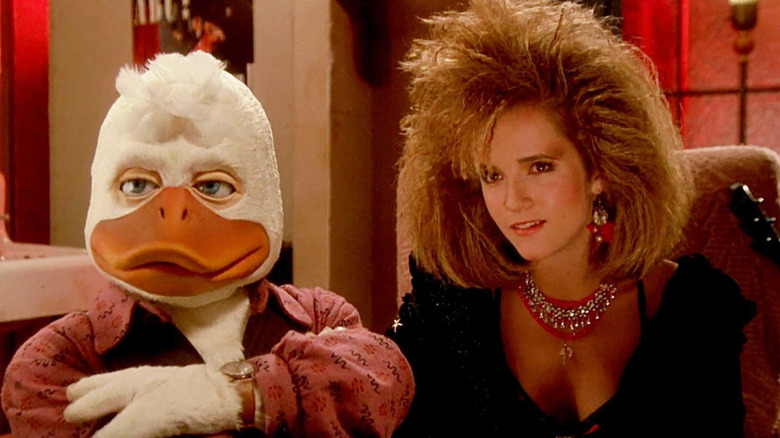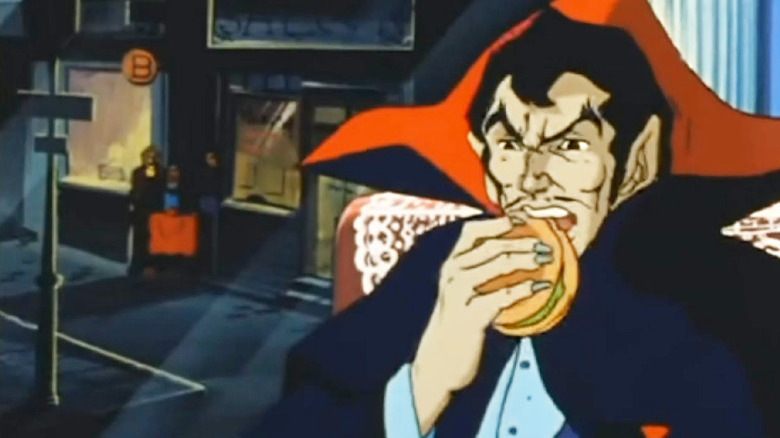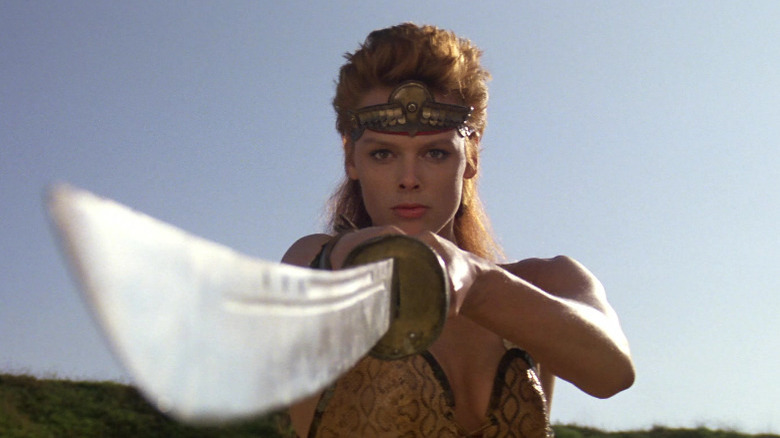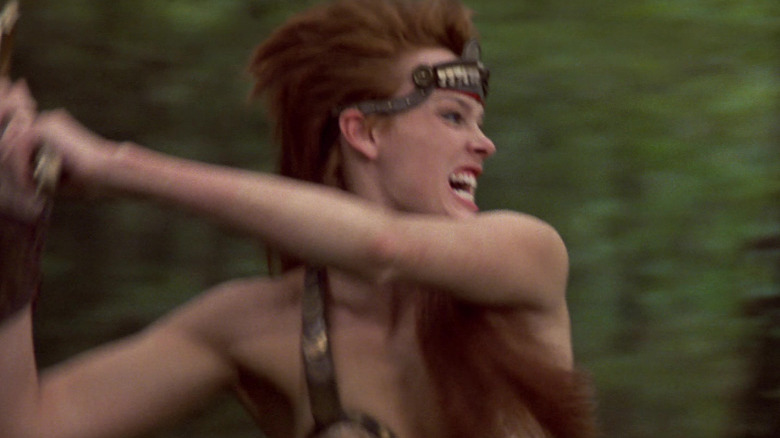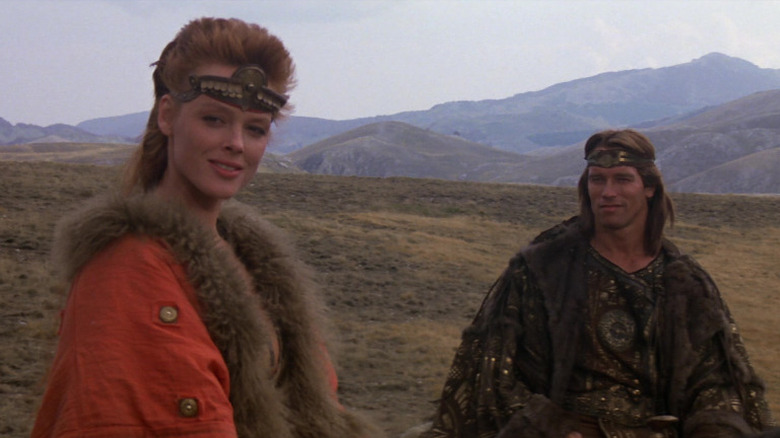Howard The Duck Isn't The First Marvel Comics Movie – The Real One Came Out One Year Earlier
It took a very long time for Hollywood to take Marvel Comics seriously, and "Howard the Duck" gets a lot of the blame for that. By the mid-1980s, films like "Star Wars" and "Superman: The Movie" had incited a proper revolution in the film industry. Genres that previously weren't big hits — financially or critically — didn't just make lots of money, but they made movie stars out of actors nobody had previously heard of and even won awards. All of a sudden, sci-fi/fantasy and pulp heroes weren't just "kids' stuff." They were surefire recipes for four-quadrant success.
But even though Marvel was churning out superhero TV shows like nobody's business — not just Saturday morning cartoons but primetime hits like "The Incredible Hulk" and "Spider-Man: The Animated Series" — Marvel's first big budget foray into live-action theatrical features wasn't based on one of their most iconic costumed crimefighters. Instead, it was "Howard the Duck," a bizarre film about a satirical character created by writer Steve Gerber and penciler Val Mayerik, in which an anthropomorphic waterfowl from another planet gets stuck in Cleveland, OH, and becomes the manager of a rock band, and fights a giant crustacean to save the planet.
"Howard the Duck" was a massive box office failure, and common wisdom dictates that it's one of the big reasons why Marvel movies didn't really get off the ground until the surprise success of "Blade" over ten years later.
But hey, at least it was the first, right?
Right?
Wrong.
Marvel's forgotten early movies
To start, it's important to remember that what qualifies as a "movie" is broader than we sometimes give it credit for. The Academy of Motion Picture Arts and Sciences, for example, says that for a movie to be eligible for the Academy Awards, it has to play in theaters, at least for a little while. But a theatrical release is not the criteria for what actually counts as a movie, it just narrows the playing field down for the Oscars. Made-for-TV movies may only be eligible for the Emmy Awards, for example, but they're still movies.
In the modern era, where some of the best films of any given year premiere on streaming services, the idea that a movie has to play in theaters to be considered a "real" one is, at best, archaic. Mostly, it's laughable. And sometimes, even that definition isn't cut and dry. The "Amazing Spider-Man" live-action TV series debuted overseas as three theatrically-released feature films, assembled from two-part episodes, entitled "Spider-Man," "Spider-Man Strikes Back," and "Spider-Man: The Dragon's Challenge." If you lived in a territory where they were theatrically released, then you might think they were the first Marvel superhero movies.
Then again, Toei released two feature-length animated films based on Marvel's horror comics, entitled "Dracula: Sovereign of the Damned" (1980) and "The Monster of Frankenstein" (1981), and the short-form theatrical release of Toei's live-action Spider-Man series (1978). There's also the "Doctor Strange" TV movie (1978) and two "Captain America" TV movies (1979), which were, of course, preceded by the "Captain America" theatrical serials all the way back in 1944.
But if you want to get picky about it, if you demand that the film we call the "first" Marvel movie be a live-action, feature-length, theatrical film based on a Marvel character that debuted exclusively in theaters?
Then no, "Howard the Duck" still doesn't count.
Red reckoning
Richard Fleischer's "Red Sonja" was the third feature film set in Hyboria, the action-packed world of high adventure created in 1932 by Robert E. Howard. The first two films, "Conan the Barbarian" and "Conan the Destroyer," were significant hits that helped launch bodybuilder Arnold Schwarzenegger into motion picture superstardom. Specifically, "Conan the Destroyer" boasted a story by Roy Thomas, whose run on Marvel's "Conan the Barbarian" comic books was enormously successful and spanned over 150 issues, as well as Gerry Conway, who co-created such classic comic book characters as The Punisher, Jason Todd, Carol Danvers, and Killer Croc.
Roy Thomas's contribution is important to acknowledge because it was Thomas who co-created, along with Barry Windsor-Smith, the character of Red Sonja in the 23rd issue of "Conan the Barbarian" back in 1973. This version of Red Sonja was loosely inspired by another character named "Red Sonya," who was created by Robert E. Howard in a 1934 short story called "The Shadow of the Vulture." Howard's version lived thousands of years after the Hyborian Age and had a completely different origin. And as you may have noticed, they even spell their names differently. They are two different characters.
The version of "Red Sonja" that made it to the screen was not Robert E. Howard's. It was the version created for Marvel Comics. She's a powerful warrior whose family was murdered and who herself was sexually assaulted, who becomes an unstoppable swordfighter and vows never to sleep with a man unless he defeats her in a fair fight. Which, since she's so damned awesome, is practically impossible.
Sonja got served
Somehow, the makers of the "Red Sonja" movie got away with using Roy Thomas and Barry Windsor-Smith's almost completely original version of the character without actually crediting them or even crediting Marvel Comics. They also seem to have tricked Arnold Schwarzenegger a little bit since the superstar only appears in a supporting role but has a title card above even Brigitte Nielsen, who plays the title character. Audiences could be forgiven for thinking they were buying tickets for a Schwarzenegger-centric film.
Brigitte Nielsen, who would play Ludmilla Drago in "Rocky IV" later that same year and would go on to co-star in the hit films "Cobra" and "Beverly Hills Cop 2," plays Red Sonja rather faithfully to the comics. Her performance is on the wooden side, but then again, so is Schwarzenegger's. Schwarzenegger plays a character named Lord Kalidor, who is kind of like Conan the Barbarian, except his name is different. Joining them is another "Conan" alum, Sandahl Bergman, who originally played the only woman Conan ever loved but now plays a different character, the villainous Queen Gedren.
"Red Sonja" is, let's be fair about this, not a particularly good movie. Richard Fleischer, who previously directed "Conan the Destroyer" as a monster-centric matinee adventure — as opposed to John Milius's "Conan the Barbarian," which was more of a serious epic — gives this film that same hokey spirit. Except this cast isn't as dazzling or as committed, and the monsters aren't as numerous or as cool.
But, and this is very important... we're not here to claim that "Red Sonja" is the first great or even good Marvel Comics movie. We're just saying it's the first. "Howard the Duck" erroneously held this distinction for decades, and after nearly 50 years, it's still generally considered a stinker, so it's not like we're taking the crown away from a beloved classic.
Better off Red
Why does any of this matter? Well, the thing about history is it means a hell of a lot more when it's accurate. "Howard the Duck" wasn't the first Marvel Comics movie by a wide margin if you acknowledge that all movies are movies regardless of whether they debut in theaters or not. But even if you insist that "Howard the Duck" deserves a special asterisk next to its name because it was the first live-action feature-length Marvel Comics adaptation that exclusively debuted in theaters, that's not really true. It's certainly not fair.
Some might argue that because the credits of "Red Sonja" don't include the name of Marvel Comics, nor do they credit Roy Thomas or Barry Windsor-Smith with creating this version of the character, reserving instead all the credit for Robert E. Howard, that doesn't mean it shouldn't count. Then again, Roger Corman claimed in the opening credits that the Vincent Price horror movie "The Haunted Palace" was based on an Edgar Allan Poe story since Poe adaptations were making lots of money at the time. But that movie was actually an adaptation of H.P. Lovecraft's "The Case of Charles Dexter Ward." For crying out loud, even the main character's name is the same. What are we supposed to believe: our eyes and ears or a title card?
"Red Sonja" may not be an official Marvel Comics adaptation, and indeed, the character isn't even published by Marvel anymore, but it was still an adaptation of a Marvel Comic at the time, so what the hell else could we call it? There's no reason to give "Red Sonja's" rightful place in Marvel movie history away just because the makers of the movie didn't give enough credit to Marvel, Roy Thomas, and Barry Windsor-Smith.
So move aside, Howard the Duck. It's Red Sonja's crown. You've been wearing it too long.
